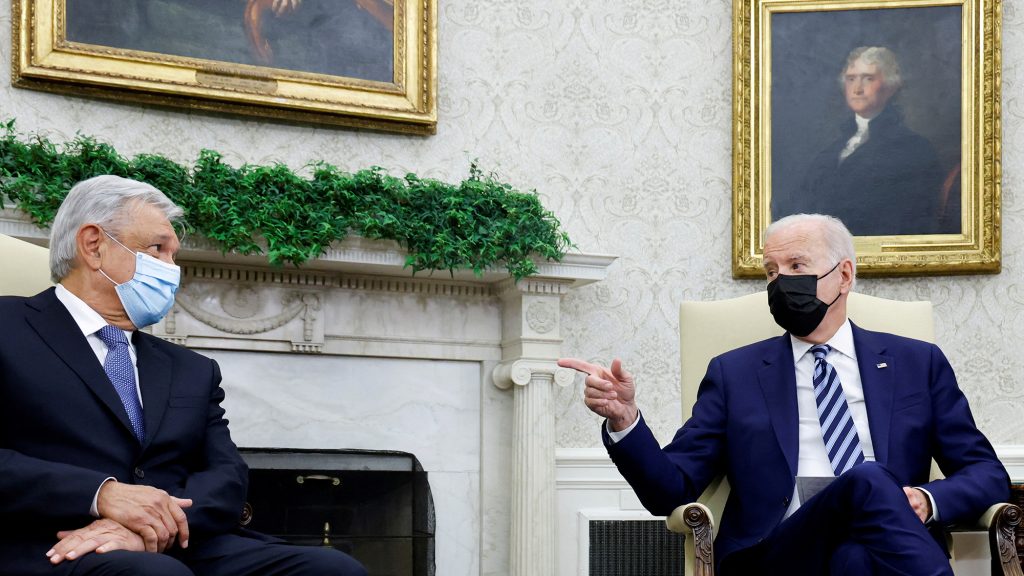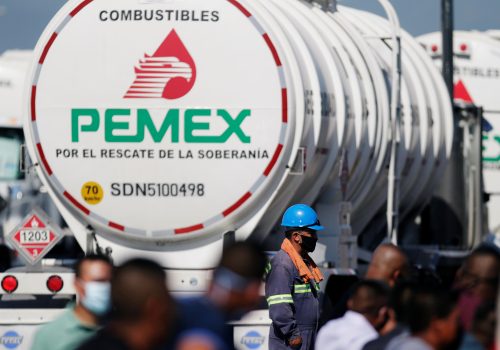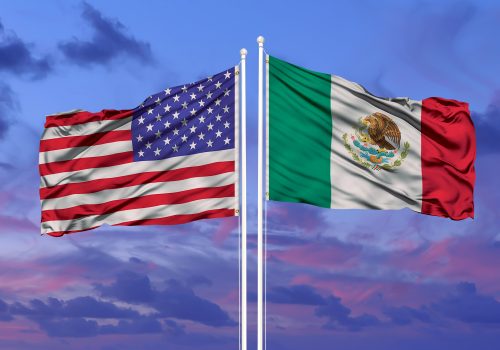The July 12 meeting between US President Joe Biden and Mexican President Andrés Manuel López Obrador (better known as AMLO) provides an opportunity for the US-Mexico-Canada Agreement (USMCA)—its progress, shortcomings, and future—to move to the top of the two countries’ shared agenda.
Following a tumultuous negotiation period, the USMCA has now been in force for two years, and its impact has been overshadowed by pressing economic issues: the COVID-19 pandemic, supply-chain problems, and inflation driven by the Russian invasion of Ukraine. Despite that, the USMCA is still important, having made critical modernizations to the North American Free Trade Agreement (NAFTA) by securing enforceable environmental commitments, strengthening workplace protections, committing Mexico to its labor reforms in recent years, and including provisions for confronting or working with “nonmarket economies” as a bloc. Critically, as the Western Hemisphere sees a boom of digital products and services, the USMCA also sets rules for trading in the digital economy, including a guarantee that data moves freely across borders.
Multiple levels of government will need to cooperate in order to harness the full economic potential of the USMCA. The rare bilateral meeting offers the perfect opportunity for Biden and López Obrador to chart the course forward together.
Two years on, the USMCA still provides guiding principles for the US-Mexico-Canada relationship. Last year’s North American Leaders’ Summit (NALS), while focusing primarily on challenges posed by the pandemic, resulted in commitments by the three countries to increase support for small- and medium-sized enterprises (SME), strengthen labor protections, and cooperate on environmental concerns, building on USMCA chapters 25, 23, and 24, respectively. The Americas Partnership for Economic Prosperity announced at last month’s Summit of the Americas echoes the USMCA’s commitments to protect biodiversity and the environment, improve labor standards, and create standards for the digital economy. It is important that the United States, Mexico, and Canada follow up on their USMCA commitments via concrete mechanisms, initiatives, and working groups. This upkeep is especially important considering that the parties are halfway to the first joint review session, where they will consider changes and updates to the agreement.
Challenges such as COVID-19 have made the quantitative impact of the USMCA hard to measure, and the reality is it’s too soon to understand precisely how it has benefited the North American economy. But what we do know is policymakers have taken new steps to enhance collaboration, particularly in the form of initiatives to strengthen supply chains. For example, Biden’s US Supply Chain Task Force is developing solutions for strained supply chains in collaboration with Mexico and Canada, among other trade partners. Furthermore, the USMCA’s Competitiveness Committee—which was suggested by Mexico during negotiations—is actively working to ensure that North American supply chains can withstand a future emergency and avoid the pitfalls and coordination failures of the COVID-19 pandemic. Beyond that, the US-Mexico Supply Chain Working Group, established at the US-Mexico High Level Economic Dialogue earlier this year, is currently exploring the semiconductor industry as a potential area for joint development.
Despite these successes, opportunities for the United States and Mexico remain untapped, threatening the potential for the countries to share growth. For example, the Competitiveness Committee has a broad mandate—beyond strengthening supply chains—to incentivize production in North America, encourage regional economic integration, harmonize regulation, improve transportation, and respond to new developments; the committee has met twice since the USMCA came into force, but it could do so more frequently to better explore its expansive remit. Other committees established by the agreement (for example, the Committee on SME Issues), offer a powerful avenue for the parties to work on shared goals at the ministerial level and maintain momentum between major summits like NALS. But these committees are currently underutilized, and the relationships between different committees are unclear. Those relationships need to be defined so that committees can cooperate with each other and fully realize their potential. Opportunities spelled out in deliverables from NALS have also been left untouched: Leadership has yet to update the North American Plan for Animal and Pandemic Influenza as promised or host a Trilateral Cyber Experts Meeting to discuss internet infrastructure and security.
Domestic politics are also threatening the potential for shared growth. As Mexico was preparing to pass a controversial energy reform this spring that seemed to have given preferential treatment to the government-run Federal Electricity Commission (CFE), US Trade Representative Katherine Tai raised objections; she also directed her office to review Mexico’s compliance with the USMCA, which includes provisions against favoring state-owned companies and for protecting the environment. While the energy-reform bill crumbled, Mexico’s 2021 law giving dispatch priority to electricity produced by the CFE has remained, as the courts recently failed to rule it unconstitutional. Tai is now reportedly considering formal consultations on the topic, which would be one of only a couple such disputes with Mexico. Mexico’s nationalization of its lithium industry in the wake of the constitutional change’s failure may also come to be considered a violation of USMCA. Such disagreement on key areas for North American cooperation—energy security, the climate crisis, and strategic mineral resources—undermines the United States and Mexico’s ability to strengthen ties and present a united front on global issues.
Looking to the future, though, the North American partners have clear, common goals thanks to the USCMA: strengthening supply chains, supporting SMEs, and equitable growth and recovery. Biden and López Obrador must use this meeting to frame the next five months of collaboration on these goals and to guide cabinet-level cooperation through to the next NALS and High-Level Economic Dialogue at the end of 2022. Together, the presidents can set the agenda for securing digitalization and environmental protection while clarifying which committees and ministers will take the lead on shared goals going forward.
The USCMA and other agreements already provide a strong framework. The two presidents must build upon it, starting now.
Jacob M. Kaufhold is a project assistant at the Atlantic Council’s Adrienne Arsht Latin America Center.
Further reading
Thu, Mar 3, 2022
What to expect from Mexico’s energy reform bill
Infographic By
Mexico's Congress is currently debating a proposed amendment to the constitution to allow the state to increase control over the country’s energy market. What can we expect from this energy reform bill?
Mon, Jul 11, 2022
Climate and energy at the US-Mexico bilateral summit
EnergySource By David L. Goldwyn, Neil Robert Brown, Andrea Clabough
Energy and climate issues will feature heavily when Mexico's president visits the White House this week. President Biden faces the tough task of fostering greater cooperation while asserting US demands for treaty compliance and a free and fair energy market.
Tue, Nov 16, 2021
Silence is assent: A path forward in US-Mexico energy and climate relations
EnergySource By David L. Goldwyn, Neil Robert Brown
Mexico's recent climate and energy measures will cause economic harm, set back emissions reduction efforts, and strain the country's relationship with the US. The Biden administration must be clear that these nationalistic policies, which contravene the United States-Mexico-Canada Agreement, will not be tolerated.
Image: FILE PHOTO: U.S. President Joe Biden welcomes Mexico's President Andres Manuel Lopez Obrador in the Oval Office at the White House in Washington, U.S. November 18, 2021. REUTERS/Jonathan Ernst/File Photo



